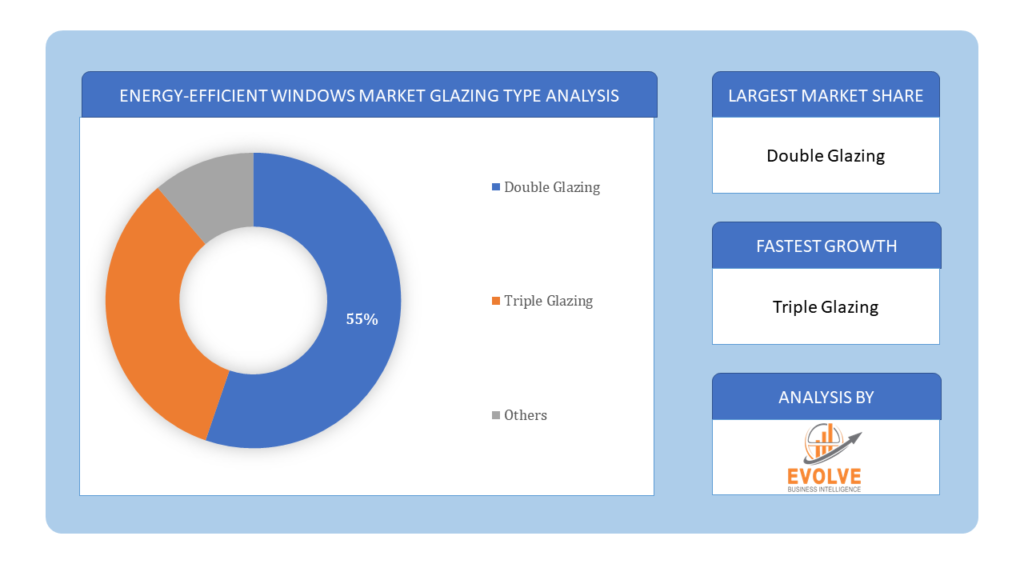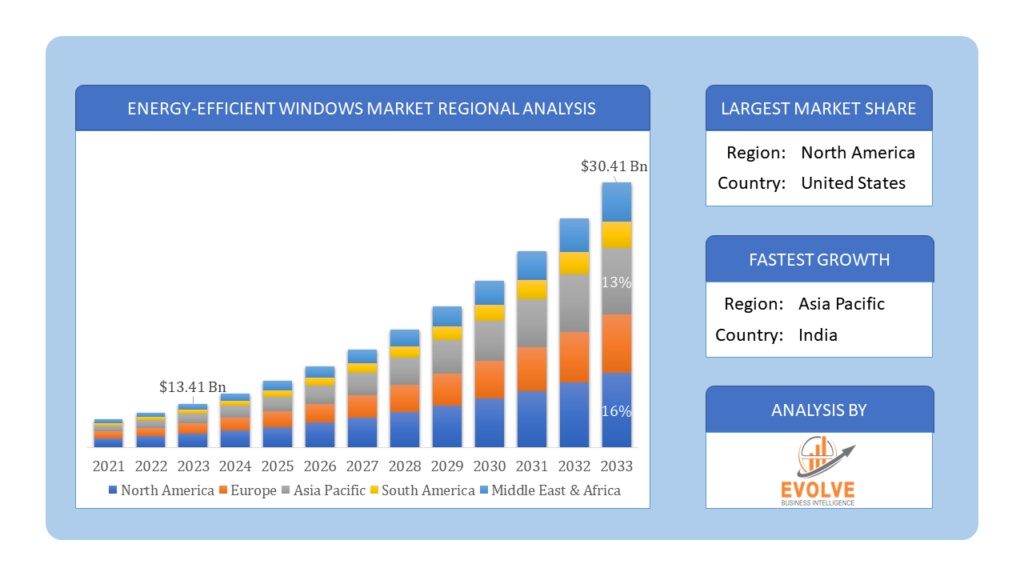Energy-efficient windows market Overview
The Energy efficient windows market Size is expected to reach USD 30.41 Billion by 2033. The Energy-efficient windows market industry size accounted for USD 13.41 Billion in 2023 and is expected to expand at a compound annual growth rate (CAGR) of 8.32% from 2023 to 2033. The energy-efficient windows market refers to the segment of the construction industry focused on the production, distribution, and installation of windows designed to minimize energy consumption within buildings. Energy-efficient windows are specially designed to reduce heat transfer and air leakage, thereby improving insulation and reducing the need for heating, cooling, and artificial lighting. These windows typically feature advanced glazing technologies, such as low-emissivity (low-E) coatings, multiple panes, inert gas fills (like argon or krypton), and insulated frames.
The market for energy-efficient windows has seen significant growth in recent years due to increasing awareness of environmental concerns, rising energy costs, and stringent building regulations aimed at reducing carbon emissions. Key players in the energy-efficient windows market include manufacturers, suppliers, contractors, and retailers who offer a variety of window products tailored to different climates, building types, and energy efficiency requirements.
Global Energy-efficient windows market Synopsis
The COVID-19 pandemic had significant impacts on the energy-efficient windows market. With lockdowns and restrictions in place, many people spent more time at home, leading to an increased focus on home improvement projects. Energy-efficient windows, aimed at reducing energy bills and improving comfort, became a popular choice for homeowners looking to upgrade their properties during this time. The shift towards remote work resulted in heightened awareness of energy consumption at home. As people spent more time indoors, the importance of energy-efficient solutions, including windows, for maintaining comfortable and cost-effective indoor environments became more apparent. Economic uncertainty resulting from the pandemic led to reduced consumer spending and investment in construction projects, including renovations and retrofits. Some homeowners and businesses postponed or scaled back their plans to upgrade to energy-efficient windows due to financial concerns.
Energy-efficient windows market Dynamics
The major factors that have impacted the growth of Energy-efficient windows market are as follows:
Drivers:
Ø Rising Energy Costs
Escalating energy costs have prompted homeowners and businesses to seek ways to reduce their energy bills. Energy-efficient windows provide better insulation, reduce heating and cooling loads, and improve overall energy efficiency, resulting in cost savings over time. Advances in window technologies, such as low-emissivity coatings, insulated frames, and triple glazing, have improved the performance of energy-efficient windows. These innovations enhance thermal insulation, minimize heat loss or gain, and enhance occupant comfort, driving demand for energy-efficient window products. Energy-efficient windows contribute to indoor comfort by reducing drafts, improving temperature regulation, and minimizing condensation and moisture issues. Additionally, they can help enhance indoor air quality by reducing the need for mechanical heating and cooling systems, leading to healthier indoor environments.
Restraint:
- Perception of High Initial Cost
Energy-efficient windows typically have a higher upfront cost compared to conventional windows. This initial investment can be a deterrent for some consumers, particularly in regions where energy prices are relatively low or where budgets for construction or renovation projects are limited. Lack of awareness and understanding about the benefits of energy-efficient windows among consumers, builders, and architects can hinder market growth. Many potential buyers may not fully appreciate the long-term cost savings and environmental benefits associated with these windows, leading them to prioritize other features or materials in their construction or renovation projects. The effectiveness of energy-efficient windows can vary depending on climate conditions, such as temperature extremes, humidity levels, and solar exposure. In regions with milder climates or where energy costs are lower, the perceived benefits of investing in energy-efficient windows may be lower, reducing market demand.
Opportunity:
⮚ Increasing Demand for Sustainable Building Solutions
Growing environmental awareness and concerns about climate change are driving demand for sustainable building materials and practices. Energy-efficient windows offer a significant opportunity to reduce energy consumption, lower carbon emissions, and enhance the sustainability of buildings, aligning with broader trends towards green construction. The vast existing building stock presents a significant opportunity for retrofitting with energy-efficient windows. As building owners and operators seek to improve energy performance and reduce operating costs, there is a growing market for retrofit projects targeting window upgrades. This presents an opportunity for manufacturers, contractors, and service providers to tap into this market segment. Increasing awareness of indoor air quality, thermal comfort, and occupant health and wellness presents an opportunity for energy-efficient windows to differentiate themselves in the market. Energy-efficient windows can help maintain comfortable indoor environments, reduce drafts, minimize condensation, and enhance overall indoor air quality, contributing to occupant health and well-being.
Energy-efficient windows market Segment Overview
By Operating Type
Based on Operating Type, the market is segmented based on Awning, Casement, Double-hung, Fixed, Hopper and Others. The awning segment will hold the largest Market share. Awning windows allow air to enter from the right, left, or bottom by opening outward. Awning windows are popular in the market for energy-efficient windows because of their straightforward operation. Since they may be mounted high on walls, these windows provide the highest level of privacy. Additionally, these windows offer good light and air circulation. Awning windows are also less expensive than other varieties.
By Glazing Type
 Based on Glazing Type, the market has been divided into Double Glazing, Triple Glazing and Others. The Double-Glazed segment held the majority share in 2021 because of increase in construction across the globe coupled with the adoption of green buildings in respect to the Energy-Efficient Window market revenue. With rising demand for both the residential and commercial sectors, a double-glazed segment is expected to grow fast throughout the projection period. These windows are used in both new and renovated buildings. Double-glazed windows significantly reduce heat loss and promote energy savings, boosting the double-glazed market in the energy-efficient window industry.
Based on Glazing Type, the market has been divided into Double Glazing, Triple Glazing and Others. The Double-Glazed segment held the majority share in 2021 because of increase in construction across the globe coupled with the adoption of green buildings in respect to the Energy-Efficient Window market revenue. With rising demand for both the residential and commercial sectors, a double-glazed segment is expected to grow fast throughout the projection period. These windows are used in both new and renovated buildings. Double-glazed windows significantly reduce heat loss and promote energy savings, boosting the double-glazed market in the energy-efficient window industry.
By Component
Based on Component, the market segment has been divided into Frame, Glass, Hardware and Others. In the Energy-Efficient Window Market in 2021, the glass sector had the biggest revenue share. In terms of energy efficiency, the choice of glass is by far the most important option in most windows. Users may also choose to select different types of skylights for various windows around the home based on a variety of window design characteristics including as climate, window orientation, building design, and many more. Hence rising components into glass, frames, and hardware implants for Energy-Efficient Windows positively impacts the market growth.
By End Use
Based on End Use, the market segment has been divided into Residential, Non-residential and Others. The residential segment in the Global Energy-efficient Windows Market is accounted for the largest market share. The growth of this segment is attributed to the extensive demand for window replacement, due to the thermal inefficiency and air leakage issues caused by ordinary single-pane windows. Commercial application is also forecast to expand at a substantial rate over the forecast timeframe.
Global Energy-efficient windows market Regional Analysis
Based on region, the global Energy-efficient windows market has been divided into North America, Europe, Asia-Pacific, the Middle East & Africa, and Latin America. North America is projected to dominate the use of the Energy-efficient windows market followed by the Asia-Pacific and Europe regions.
 Energy-efficient windows North America Market
Energy-efficient windows North America Market
North America holds a dominant position in the Energy-efficient windows market. The North American market for energy-efficient windows is relatively mature, driven by stringent building codes, energy efficiency programs, and consumer demand for sustainable solutions. Extreme climates in regions like the northern United States and Canada lead to a higher demand for energy-efficient windows, particularly those with enhanced insulation properties. Energy Star certification is a significant driver, incentivizing the adoption of energy-efficient windows through rebates and tax credits.
Energy-efficient windows Asia-Pacific Market
The Asia-Pacific region has indeed emerged as the fastest-growing market for the Energy-efficient windows market industry. Rapid urbanization, increasing construction activity, and rising awareness of energy efficiency are driving market growth in countries like China, Japan, South Korea, and Australia. Government initiatives to improve building energy efficiency, such as China’s Green Building Evaluation Standard and Japan’s Top Runner Program, are driving demand for energy-efficient windows. Increasing disposable income and changing lifestyles contribute to the growth of the retrofit market, particularly in urban areas.
Competitive Landscape
The global Energy-efficient windows market is highly competitive, with numerous players offering a wide range of software solutions. The competitive landscape is characterized by the presence of established companies, as well as emerging startups and niche players. To increase their market position and attract a wide consumer base, the businesses are employing various strategies, such as product launches, and strategic alliances.
Prominent Players:
- Andersen Corporation
- JELD-WEN Inc.
- Marvin
- Masco Corporation
- PGT Innovations
- Ply Gem Residential Solutions
- REHAU Incorporated
- VKR Holdings A/S
- Deceuninck NV
- YKK Group.
Key Development
In February 2022, Jeld-Wen introduced Stormsure Express, a collection of colored timber windows. The window provides a wide collection of 36 design options varies in configurations and size. Additionally, Stormsure Express is six of Jeld-Wen’s most famous colors.
In March 2023, Pella Corporation announced that it has acquired Milgard Windows and Doors. This acquisition will expand Pella’s product portfolio and make it a leading provider of energy-efficient windows in the United States.
Scope of the Report
Global Energy-efficient windows Market, by Operating Type
- Awning
- Casement
- Double-hung
- Fixed
- Hopper
- Others
Global Energy-efficient windows market, by Glazing Type
- Double Glazing
- Triple Glazing
- Others
Global Energy-efficient windows market, by Component
- Frame
- Glass
- Hardware
- Others
Global Energy-efficient windows market, by End Use
- Residential
- Non-residential
- Others
Global Energy-efficient windows market, by Region
- North America
- US
- Canada
- Mexico
- Europe
- UK
- Germany
- France
- Italy
- Spain
- Benelux
- Nordic
- Rest of Europe
- Asia Pacific
- China
- Japan
- South Korea
- Indonesia
- Austalia
- Malaysia
- India
- Rest of Asia Pacific
- South America
- Brazil
- Argentina
- Rest of SouthAmerica
- Middle East &Africa
- Saudi Arabia
- UAE
- Egypt
- SouthAfrica
- Rest of Middle East & Africa
| Parameters | Indicators |
|---|---|
| Market Size | 2033: $30.41 Billion |
| CAGR | 8.32% CAGR (2023-2033) |
| Base year | 2022 |
| Forecast Period | 2023-2033 |
| Historical Data | 2021 |
| Report Coverage | Revenue Forecast, Competitive Landscape, Growth Factors, and Trends |
| Key Segmentations | Operating Type, Glazing Type, Component, End Use |
| Geographies Covered | North America, Europe, Asia-Pacific, Latin America, Middle East, Africa |
| Key Vendors | Andersen Corporation, JELD-WEN Inc., Marvin, Masco Corporation, PGT Innovations, Ply Gem Residential Solutions, REHAU Incorporated, VKR Holdings A/S, Deceuninck NV and YKK Group |
| Key Market Opportunities | • Increasing Demand for Sustainable Building Solutions • Health and Wellness Considerations |
| Key Market Drivers | • Rising Energy Costs • Health and Comfort Considerations |
REPORT CONTENT BRIEF:
- High-level analysis of the current and future Energy-efficient windows market trends and opportunities
- Detailed analysis of current market drivers, restraining factors, and opportunities in the future
- Energy-efficient windows market historical market size for the year 2021, and forecast from 2023 to 2033
- Energy-efficient windows market share analysis at each product level
- Competitor analysis with detailed insight into its product segment, Government & Defense strength, and strategies adopted.
- Identifies key strategies adopted including product launches and developments, mergers and acquisitions, joint ventures, collaborations, and partnerships as well as funding taken and investment done, among others.
- To identify and understand the various factors involved in the global Energy-efficient windows market affected by the pandemic
- To provide a detailed insight into the major companies operating in the market. The profiling will include the Government & Defense health of the company’s past 2-3 years with segmental and regional revenue breakup, product offering, recent developments, SWOT analysis, and key strategies.








